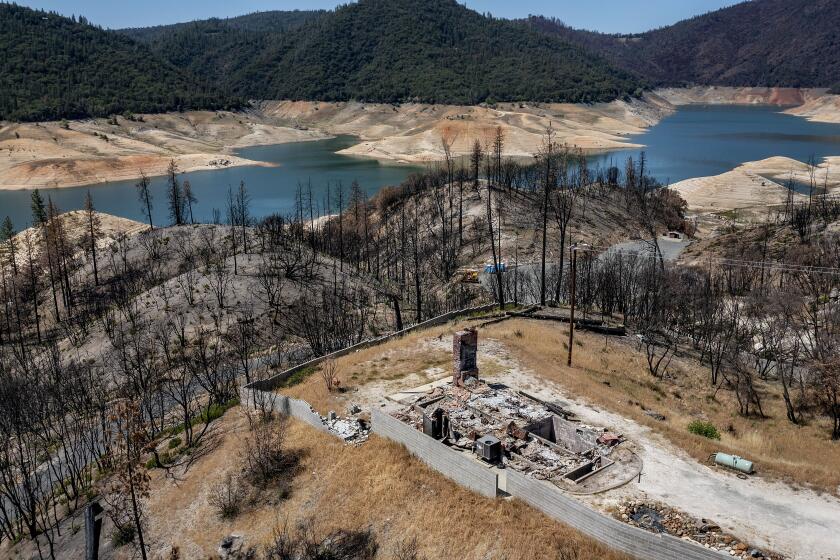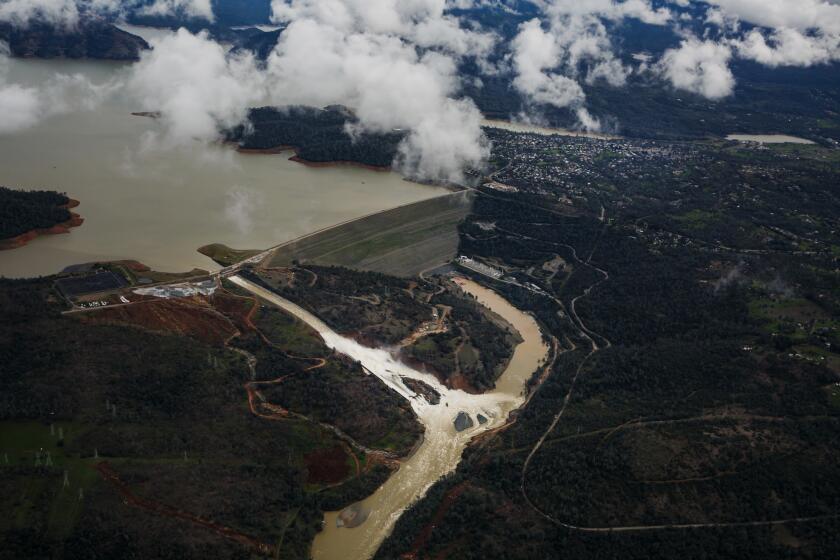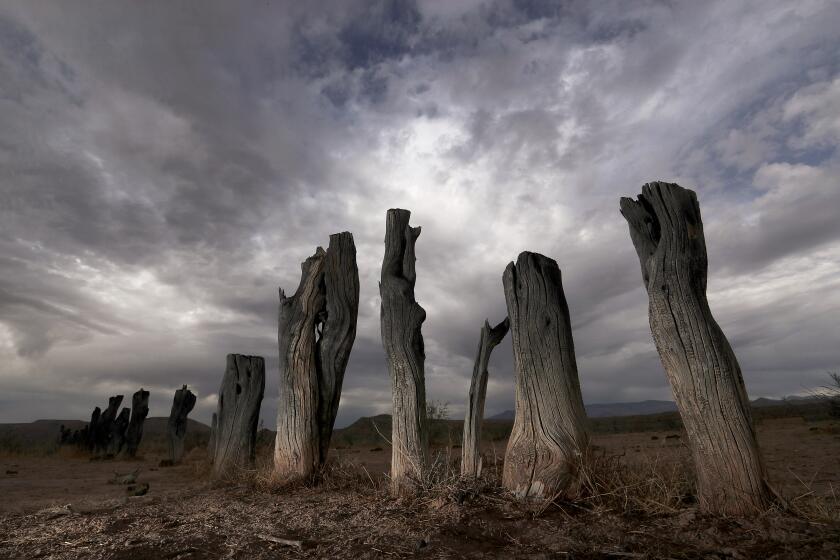As drought lingers, larger and more destructive wildfires pose new threats to water supply
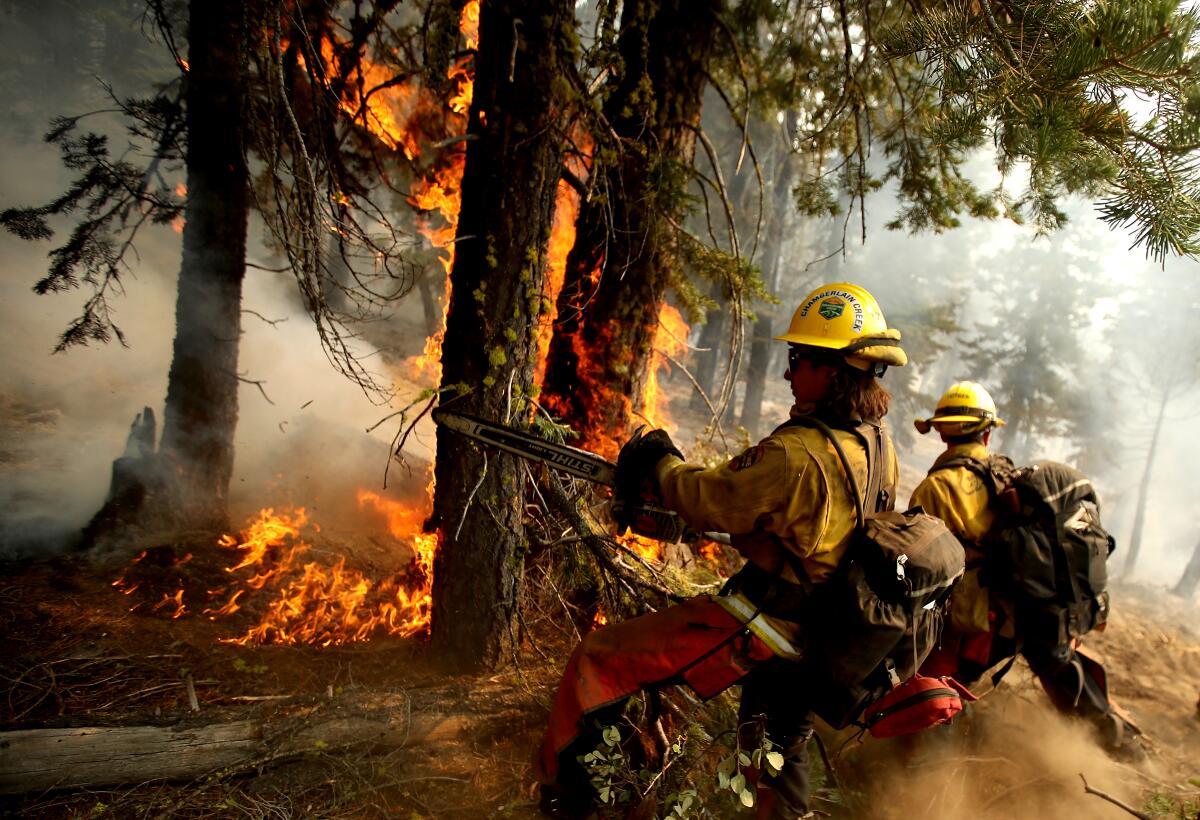
- Share via
Already diminished by drought and extreme heat, California’s water supply will face yet another peril as wildfires continue to incinerate ever larger areas of forested land, according to new research.
In a UCLA-led study published Monday in the journal Proceedings of the National Academy of Sciences, researchers determined that increasing forest fire activity is “unhinging” western U.S. stream flow from its historical predictability. In areas where more than a fifth of the forest had burned, stream flow increased by an average of 30% for six years after the fire.
On its surface, increased stream flow — the rate at which water is carried by rivers and streams — could be seen as a boon for the drought-stricken region. But too much water comes with hazards, including increased erosion, flooding and debris flows.
“Water is a really heavy, destructive thing, so when there’s too much of it, or when we get surprised by a large amount of water at once, it’s definitely not a good thing,” said Park Williams, an associate professor of geography at UCLA and one of the study’s lead authors.
The findings underscore how extreme wildfire can alter long-established water cycles. Now, as the state moves into a new era of heat, flames and dryness driven by climate change, the conversation around water in the West must increasingly account for fire.
“We need to be adapting quickly, because the fires are increasing in size and intensity, despite our best efforts to continue controlling them,” Williams said. “We — and our hydrological infrastructure — are not really suited to deal with it.”
The three big water basins of the Sierra Nevada — the Sacramento, San Joaquin and Tulare — “should all be on the precipice now of having experienced enough recent forest fire to cause surprisingly high stream flows,” he said.
Sediment from massive blazes chokes rivers and reservoirs, contaminating water supplies. Climate change is making the problem worse.
According to the study, annual forest fire area in the western United States increased by more than 1,100% from 1984 to 2020, the year of the worst wildfire season in California’s modern history.
With that explosion in fire activity came a new world of hazards and threats, including entire towns leveled by flames and the emergence of new fire behavior, such as the two fires in 2021 that became the first to ever burn across the Sierra.
But the relationship between wildfire and water is one that is only beginning to be understood. Much of the state’s infrastructure and water management system were designed around the climate and forests of the previous century, and are less suited to the realities of the current era.
Now, the state’s increasingly large and severe fires are searing through trees, shrubs and canopies that typically absorb moisture, leaving more water to run into streams, according to the study.
What’s more, severe fires can “bake” the soil, making it more waxy and water-repellent. And with less vegetation to hold topsoil in place, more flooding and erosion are occurring — sometimes with catastrophic consequences, as in the deadly mudflow in Montecito in 2018, which killed 23 people.
Runoff, particularly after severe fire, is also often accompanied by large sediment loads that can reduce water quality, said Bill Short, manager of forest and watershed geology at the California Geological Survey, who was not involved in the study.
After a wildfire, “you can have larger floods in these watersheds, and also other effects [such as] erosion, debris flows and water quality impacts from sediment and burned constituents,” Short said.
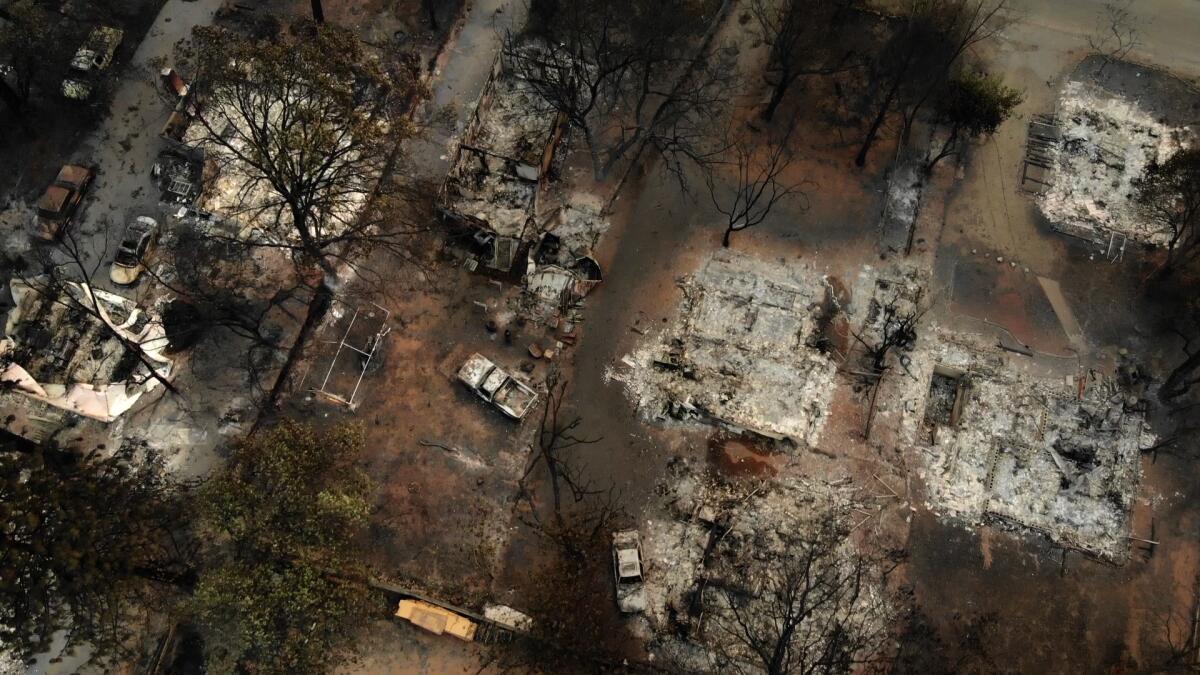
The town of Paradise — which was devastated by the 2018 Camp fire — has been plagued by chemicals and contaminants that entered the water supply during and after the wildfire, including ash and charred soils as well as plastic pipes and other synthetic materials that burned.
The impact of increased stream flow will also create new challenges beyond the potential for more debris and erosion.
For the state’s water managers, who are tasked each year with calibrating California’s critical supplies, releasing too much water ahead of an anticipated deluge could backfire, leading to less supply than needed during the hot and dry summer.
On the other hand, failing to let out enough water could be similarly disastrous, as in the 2017 Oroville Dam crisis, which sent more than 100,000 people fleeing from from a potential surge of overflowing water.
“Anytime we change the timing and rate of runoff from what historically could be expected — the results of wildfire, dry soils, increased temperatures, etc. — we challenge water management practices and have to adapt,” David Rizzardo, manager of the California Department of Water Resources’ hydrology section, said via email.
According to Rizzardo, the effects of recent so-called megafires on water supplies are still a “relatively new phenomena” that forecasters are working to unpack and incorporate.
“Fires do not burn uniformly, so their impacts vary greatly within a watershed,” he said. “It is quite complex and will take time to understand and learn from the experts.”
Jeffrey Mount, a water scientist at the Public Policy Institute of California, said there isn’t yet a definitive strategy on how to deal with the effects of fire on water supply because “we don’t really understand it all that well.”
“You see spectacular flooding after fires,” said Mount, who was not involved in the study. “Yes, you might be getting more water, but you also might be getting it when you don’t want it, getting more than you want, and it might come with a lot of sediment and debris that creates a new management headache.”
Bill Croyle stood in front of an aerial photo of Lake Oroville and swept his hand across the top of the emergency spillway that was helping drain water out of the brimming reservoir.
One of the most pressing questions has to do with the scale of the problem.
If one small watershed burns and sees a 30% increase in runoff, that’s a reasonable number, Mount said, but that’s not necessarily what’s happening. According to the California Department of Forestry and Fire Protection, the five largest wildfires recorded in California have all burned in the last five years.
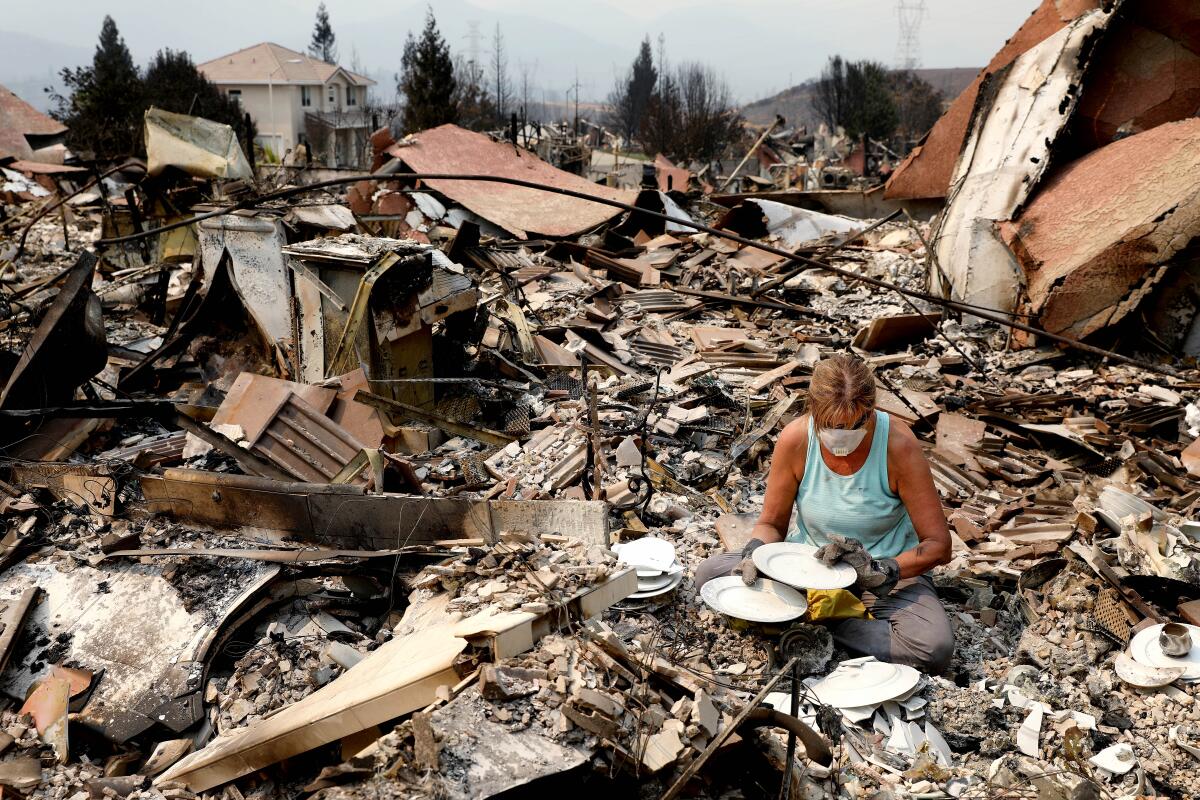
And some areas are seeing far more than a fifth of their acreage burned. Since 2018, more than 54% of the Feather River watershed has been burned in blazes such as the Dixie fire, North Complex fire and Camp fire, said Cal Fire watershed protection program manager Drew Coe.
Though the researchers primarily used stream flow data from smaller basins across the western U.S., the results suggest that burned areas will soon grow large enough to affect stream flow at a much larger scale.
Williams, the study’s author, said forest fires are now becoming large enough that “we think it should actually be making a difference in the water budget of entire regions.”
The study found a drop-off in runoff at about six years post-fire, although Williams said more research will be needed to study the longer-term effects.
Today’s fires are also burning with extreme intensity because of the buildup of dense, dry vegetation throughout the state’s forests.
Some experts said the conditions will create challenges for river and forest ecosystems, many of which are getting hotter and drier.
“With warming climate, these forested areas are on a precipice,” Coe said. “And a larger megafire coupled with drought may force it into a completely different vegetation type, and each of those vegetation types has a different characteristic hydrologic regime associated with them.”
Jay Lund, co-director of the Center for Watershed Sciences at UC Davis, agreed.
“We will be having some really major difficulties operating these systems to support native ecosystems, forest ecosystems and aquatic ecosystems,” Lund said, noting that invasive species better adapted to heat, fire and drought conditions may begin to replace the natives.
The West is experiencing its most severe megadrought in a millennium, according to a new study. Scientists say climate change is playing a major role.
But the potential water rush isn’t all bad — and neither is more fire, the experts said.
California evolved with wildfire and is in many ways adapted to its rhythms. Forest management tools such as prescribed burns could be a key piece of the puzzle, because fires in forests treated with prescribed burns and other thinning practices would be more likely to burn at a lower intensity and have a less deleterious effect on stream flows, multiple experts said.
Short, of the California Geological Survey, said preparedness will also help.
“Under this new and evolving climatic regime, we see these megafires and the number of fires increasing,” he said. “Water managers, water supply distributors should be evaluating their own treatment systems and assessing whether they can effectively treat water that has been impacted through these fires — whether it be sediment or the byproducts of ash or burned houses.”
While the notion of increased stream flow could be seen as a welcome anomaly for the dry West, Williams cautioned that it’s very rare for there to be “just enough.”
“Usually the case is not enough, or too much at once,” he said.
